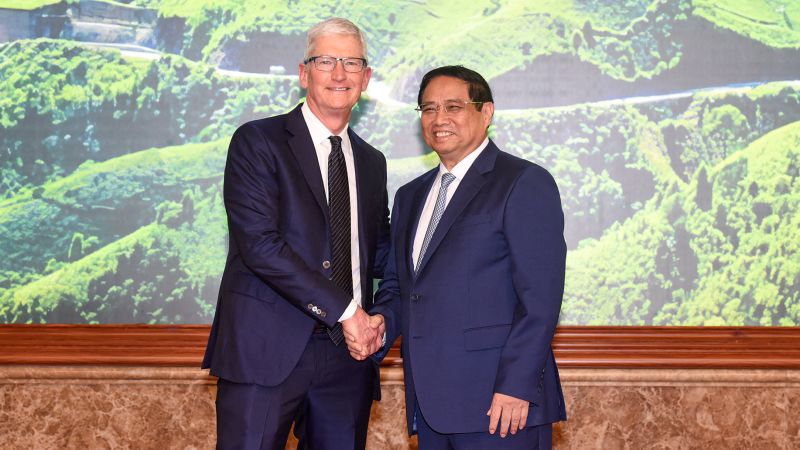Apple is planning to buy more components from Vietnam, underscoring a trend among global tech firms to look beyond China to secure their supply chains, cut costs and open up new markets.
CEO Tim Cook made the pledge in a meeting with Vietnamese Prime Minister Pham Minh Chinh in Hanoi Tuesday, according to a statement by Vietnam’s government.
Apple (AAPL) has already spent almost $16 billion through its supply chain in the country since 2019, the government quoted Cook as saying. And the company has created more than 200,000 jobs in Vietnam, it added.
According to the statement, Cook said Apple “stands ready … to enhance cooperation and investment activities” in the Southeast Asian country.
His visit highlights Vietnam’s growing importance to global companies looking for alternatives to China as trade tensions between Beijing and the West have escalated in recent years.
Vietnam has been a “major beneficiary” of moves by multinational companies to diversify their manufacturing hubs — a strategy known as “China plus one” — says Thuy Anh Nguyen, a strategist at Dragon Capital, a local fund management firm that invests solely in Vietnamese companies.
Nguyen, whose firm manages $6 billion in assets, told CNN that labor costs in Vietnam’s manufacturing sector are about half those in neighboring China.
That has helped Vietnam go from producing mostly “low-value products” like textiles to more tech products like iPhones and iPads, she said. “Those are higher-value items. That’s how we move up the value chain.”
Vietnam pulled in more than $4.29 billion in foreign direct investment during the first two months of the year, up almost 39% from the same period in 2023, according to the country’s Ministry of Planning and Investment. Most of the new investment went into the processing and manufacturing sector.
A ‘perfect landing spot’
In recent years, fast-growing Asian economies like Vietnam and India have emerged as alternative locations for manufacturers as ties between Beijing and the West have frayed.
Vietnam is “the perfect landing spot for tech companies to diversify outside China,” according to Dan Ives, a senior equity analyst at Wedbush Securities, who pointed to the high number of trained engineers in the country as one factor.
“We’re not just talking about (manufacturing of) low-cost electronics,” he told CNN. “We’re talking higher up the value chain… That was not even on the radar (of foreign companies) two years ago.”
Once enemies in war, the United States and Vietnam have grown increasingly close — the value of US imports of Vietnamese goods soared more than 360% in the decade to end-2023 to top $144 billion, according to US government data.
In September, the two countries formally upgraded their diplomatic ties to a “comprehensive strategic partnership,” a symbolic yet highly important move that positions Vietnam as a destination for more US investment, including for critical technologies like semiconductor chips.
Intel (INTC) has also taken note of Vietnam’s rise. In 2021, the company committed $1.5 billion to a sprawling campus just outside Ho Chi Minh City, which it says will be its largest single assembly and test facility in the world.
At the same time, relations between the United States and China have deteriorated. A trade war between the two countries, which began in 2018 when Washington slapped tariffs on many Chinese imports, ratcheted up last year as both sides introduced tit-for-tat chipmaking export controls.
During the pandemic, meanwhile, China’s strict zero-Covid policy scrambled global supply chains, demonstrating the risks of concentrating production in a single location.
Notably, the world’s biggest iPhone factory, located in central China and owned by Taiwanese manufacturing firm Foxconn, was forced to temporarily shut down in 2022 after workers revolted over fears of the spread of coronavirus.
Vietnam has another advantage, says Nguyen: A booming, educated, and youthful population. That’s a big draw for foreign tech companies looking to hire workers for their factories, and find consumers for their products.
“Vietnam has a population of 100 million people. If it was in Europe, it would be the biggest country,” she said, also noting that smartphone adoption in Vietnam was rapidly increasing.
The International Monetary Fund expects Vietnam’s economy to growth 5.8% this year, much faster than the predicted global average of 3.2%. For 2025, the fund forecasts growth of 6.5% in Vietnam. That’s not far off India’s pace of expansion.
Still, Vietnam represents a far smaller market than India, which has also been wooing large foreign companies, including Tesla (TSLA), to set up factories in the country.
For now, Vietnam’s attractiveness to foreign firms is “more around supply than demand,” says Ives at Wedbush Securities, while, for India, it encompasses both.
Juliana Liu contributed reporting.
Read the full article here




